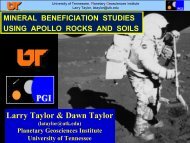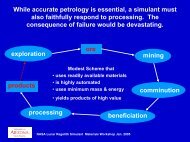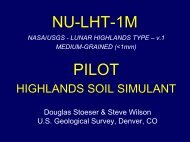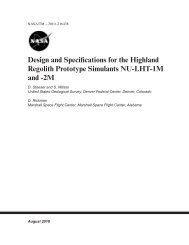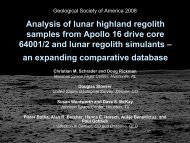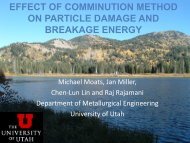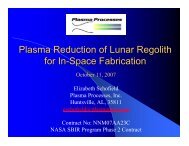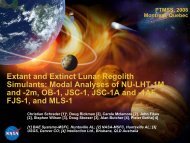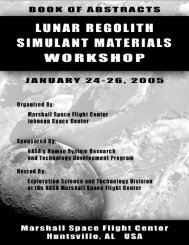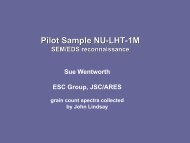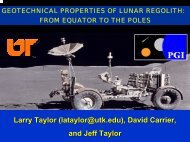Figure of Merit Characteristics Compared to Engineering Parameters
Figure of Merit Characteristics Compared to Engineering Parameters
Figure of Merit Characteristics Compared to Engineering Parameters
You also want an ePaper? Increase the reach of your titles
YUMPU automatically turns print PDFs into web optimized ePapers that Google loves.
3.2.5 Surface AreaSurface area is a function <strong>of</strong> particle size and shape distribution, and its bulk density willdetermine the surface area exposed in a given volume <strong>of</strong> material. Surface area is uniquely constrainedby these parameters, but effective surface area defined as surface area available for contactis more largely dependent on the type <strong>of</strong> packing that may not be uniquely described by the bulkdensity parameter.3.2.6 FriabilityMost simulants are expected <strong>to</strong> be unconsolidated on the bulk scale and thus friability,defined as the tendency <strong>to</strong> reduce <strong>to</strong> finer particles under stress, is not applicable. Individual particlesin a simulant or regolith such as breccias may be friable. Although friability and other measurements<strong>of</strong> mechanical strength are important considerations in simulant production, theseproperties <strong>of</strong> lunar regolith have not been measured adequately enough <strong>to</strong> simulate them.3.2.7 PermeabilityPermeability is a function <strong>of</strong> the particle shape and size distribution and bulk density. Itmay not be uniquely constrained by these characteristics.3.3 Grain SpecificSize and shape are not defined by the 2005 workshop report. These concepts can only begiven physical meaning by defining a specific method <strong>of</strong> measurement. Many <strong>of</strong> the measurementmethods have physical meaning or are only applied <strong>to</strong> assemblies <strong>of</strong> particles.3.3.1 Grain SizeThis is an explicit part <strong>of</strong> the FoM standard.3.3.2 Grain Size DistributionThis is an explicit part <strong>of</strong> the FoM standard.3.3.3 Grain ShapeThis is an explicit part <strong>of</strong> the FoM standard.3.3.4 Magnetic Grain PropertiesMagnetic properties derive from the mineralogy, grain or particle size, and environmentalhis<strong>to</strong>ry <strong>of</strong> the particle. For example, heating above a material specific temperature will cause aradical change in magnetic response. Subsequent cooling will change it yet again. In lunar materials,particle composition should determine most <strong>of</strong> the magnetism <strong>of</strong> the bulk material, but9



